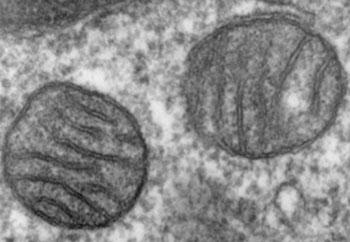Parkinson's Disease Linked to Malfunctions in Mitochondrial Fission and Fusion
By LabMedica International staff writers
Posted on 17 Nov 2014
Neurodegenerative diseases researchers in the United Kingdom have found that development of Parkinson's disease (PD) is linked to malfunctions in the processes that regulate mitochondrial fission and fusion.Posted on 17 Nov 2014
Mitochondrial dysfunction has been reported in both the familial and sporadic forms of PD. Mitochondria are constantly fusing and dividing with each other, forming large, reticular networks. To study the molecular regulators of these processes, investigators at Plymouth University (United Kingdom) used two complementary mouse models of mitochondrial impairments as seen in PD: the PTEN-induced putative kinase-1 deletion (PINK1−/−) and the 1-methyl-4-phenyl-1,2,3,6-tetrahydropyridine mouse models.

Image: Two mitochondria from mammalian tissue displaying their matrix and membranes as shown by electron microscopy (Photo courtesy of Wikimedia Commons).
They reported in the November 5, 2014, online edition of the journal Nature Communications that blocking the action of the mitochondrial fission protein GTPase dynamin-related protein-1 (Drp1) using either gene-therapy or a chemical approach reduced both cell death and deficits in dopamine release, which effectively reversed PD progression in both models.
Drp1 is a member of the Dynamin enzyme family of large GTPases. Drp1 controls the final part of mitochondrial fission, pinching off the membrane stalk between two forming daughter mitochondria. Several studies have indicated that Drp1 is essential for proper embryonic development, and that in humans, loss of Drp1 function affects brain development and is also associated with early mortality.
Senior author Dr. Kim Tieu, associate professor of clinical neurobiology at Plymouth University, said, "Our findings show exciting potential for an effective treatment for PD and pave the way for future in-depth studies in this field. It is worth noting that other researchers are also targeting this mitochondrial fission/fusion pathway as potential treatments for other neurological diseases such as Alzheimer's disease, Huntington's disease and Amyotrophic Lateral Sclerosis."
Related Links:
Plymouth University













